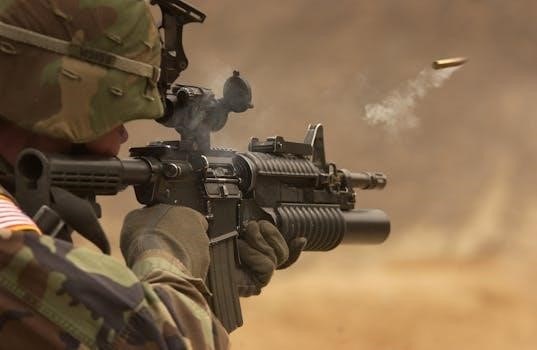4-3 Defense Playbook PDF⁚ An Overview
The 4-3 defense remains a popular and effective strategy in football. A playbook, often in PDF format, is crucial for coaches. It helps in teaching players about defensive positions, formations, blitz packages, and coverage schemes.
The 4-3 defense is a fundamental scheme in American football, characterized by four down linemen and three linebackers. It’s a balanced approach, designed to effectively counter both running and passing plays; The alignment typically features two defensive ends, a nose guard, and a defensive tackle forming the defensive line. This front aims to control the line of scrimmage, disrupt offensive blocking schemes, and pressure the quarterback.
Linebacker roles are vital, requiring a combination of run-stopping ability and pass coverage skills. The 4-3 defense’s enduring popularity stems from its adaptability and relative simplicity, making it a staple at various levels of football. Coaches utilize detailed playbooks, often in PDF format, to educate players on their specific responsibilities and techniques within the scheme, ensuring cohesive execution on the field and to maximize the strengths of the defensive.

Key Components of a 4-3 Defense Playbook
A 4-3 defense playbook details defensive line techniques, linebacker responsibilities, and secondary coverage schemes. It provides formations, blitz packages, and adjustments, crucial for executing the defense effectively.
Defensive Line Positions and Techniques
In a 4-3 defense, the defensive line consists of four players⁚ two defensive ends and two defensive tackles. Typically, one tackle plays the 1-technique (nose guard), while the other plays the 3-technique. Defensive ends usually line up in a 5-technique. Techniques involve gap control, pass-rushing moves, and run-stopping strategies.
The defensive line is critical. Linemen must be able to engage blockers, maintain gap integrity, and pressure the quarterback. Each player has specific responsibilities based on the play call and formation. Effective execution requires discipline, strength, and agility.
The playbook outlines various techniques and drills to develop these skills. Mastering these techniques is essential. This helps the defensive line dominate the line of scrimmage.
Linebacker Roles and Responsibilities
In a 4-3 defensive scheme, three linebackers play crucial roles, each with specific responsibilities. These are typically designated as the Sam (strong-side), Mike (middle), and Will (weak-side) linebackers. Each linebacker has different tasks based on their positioning and the play call.
The Mike linebacker often serves as the quarterback of the defense. He is responsible for reading the offensive formation. He must also communicate adjustments to the defensive line and secondary. The Sam linebacker typically aligns to the strong side, focusing on run support and covering tight ends. The Will linebacker plays on the weak side, often tasked with pass coverage and blitzing.
The playbook details specific reads, coverage assignments, and blitz packages. These are designed for each linebacker position, based on various offensive formations and play calls. Success depends on their ability to quickly diagnose plays. They must also execute their assignments effectively.
Secondary Coverage Schemes
The secondary in a 4-3 defense consists of cornerbacks and safeties. They are responsible for pass coverage and providing support against the run. A 4-3 playbook outlines various coverage schemes. These include Cover 2, Cover 3, Cover 4, and man-to-man. Each scheme has its strengths and weaknesses.
Cover 2 typically involves two deep safeties, splitting the field in half, while cornerbacks handle the flats; Cover 3 features three deep defenders, usually two cornerbacks and a safety, dividing the field into thirds. Cover 4, also known as “quarters,” has four deep defenders, offering a more conservative approach. Man-to-man coverage assigns each defensive back to a specific offensive receiver.
The playbook details the responsibilities of each defensive back. It depends on the coverage called and the offensive formation. Communication, technique, and discipline are vital for the secondary’s success.

Popular 4-3 Formations and Alignments
The 4-3 defense employs various formations to counter different offensive schemes. Common alignments include the Over and Under fronts. Each shifts the defensive line to create favorable matchups and exploit weaknesses.
4-3 Under Front
The 4-3 Under front is a defensive formation where the defensive line is shifted towards one side of the offensive line, often away from the tight end. Typically, the nose guard aligns in a 1-technique, shading to the weak side guard, while the defensive tackle plays a 3-technique, aligned outside of the strong side guard.
This creates an imbalance, aiming to disrupt the offensive blocking scheme and generate pressure. The defensive ends then align in 5-techniques, outside the offensive tackles. Linebacker responsibilities adjust based on the shift, emphasizing gap control and pass coverage to maintain a balanced defense.
The Under front is flexible, allowing for various blitz packages and coverage rotations. The formation is designed to be effective against both run and pass plays, but requires coordinated execution and quick adjustments.
4-3 Over Front
The 4-3 Over front is a defensive alignment where the defensive line shifts its strength towards the strong side of the offensive formation, typically the side with the tight end. In this formation, the 3-technique defensive tackle aligns on the outside shoulder of the strong side guard, aiming to penetrate and disrupt the backfield.
The nose tackle usually aligns in a 1-technique, shading the center to control the A-gap. The defensive end on the weak side often plays a 5-technique, aligned outside the offensive tackle, focusing on pass rushing and containing the run; The strong side defensive end may align in a 7-technique.
Linebacker responsibilities are adjusted to complement the shifted defensive line, with emphasis on filling gaps and covering passing lanes. This front is designed to be stout against the run and provide pressure on the quarterback.

Blitz Packages in a 4-3 Defense
Blitz packages in a 4-3 defense involve sending extra defenders to pressure the quarterback. These can include linebacker blitzes and defensive back blitzes, designed to disrupt the offensive line and create negative plays.
Linebacker Blitzes
In a 4-3 defensive scheme, linebacker blitzes are crucial for generating pressure on the quarterback and disrupting the offensive backfield. The linebackers, typically the Mike (middle), Sam (strong side), and Will (weak side) linebackers, are strategically sent on blitzes from various angles and positions. These blitzes often involve timing and coordination with the defensive line to create confusion and overload protection schemes.
Linebacker blitzes can be designed to exploit specific weaknesses in the offensive line or to target the quarterback directly. Common blitzing techniques include delayed blitzes, where the linebacker initially shows pass coverage before suddenly attacking, and A-gap blitzes, where the linebacker shoots between the center and guard. Effective linebacker blitzes require quick decision-making, speed, and the ability to navigate through blockers to reach the quarterback or disrupt running plays. Playbooks detail specific assignments and techniques for each linebacker in various blitz scenarios.
Defensive Back Blitzes
Defensive back blitzes in a 4-3 defense add an element of surprise and unpredictability to the pass rush. Cornerbacks and safeties are strategically deployed to pressure the quarterback, often from unexpected angles and depths. These blitzes are designed to exploit mismatches and create confusion in the offensive protection scheme. A well-timed defensive back blitz can disrupt passing lanes and force quick decisions from the quarterback, leading to sacks, interceptions, or hurried throws.
Common defensive back blitz techniques include corner blitzes off the edge, safety blitzes through the A-gap, and delayed blitzes where the defensive back initially shows coverage before attacking. Effective defensive back blitzes require excellent timing, speed, and disguise to avoid detection by the offensive line. Playbooks detail specific assignments, routes, and coverage adjustments for defensive backs in various blitz scenarios. Furthermore, coaches consider the risk-reward factor, ensuring adequate coverage support behind the blitz to prevent big plays.

Notable 4-3 Defense Playbooks and Coaches
Several coaches have mastered the 4-3, creating successful playbooks. Tony Dungy and Monte Kiffin’s Tampa Bay Buccaneers defense stands out. College programs also showcase effective 4-3 schemes.
Tony Dungy and Monte Kiffin (Tampa Bay Buccaneers)
Tony Dungy and defensive coordinator Monte Kiffin crafted a legendary 4-3 defense with the Tampa Bay Buccaneers. Their system, emphasizing speed and relentless pursuit, revolutionized the game. The “Tampa 2” scheme became synonymous with their success, showcasing a disciplined approach to zone coverage and aggressive run stopping. Their playbook focused on minimizing mistakes, forcing turnovers, and maximizing player strengths.
Key elements included a dominant defensive line, athletic linebackers, and a ball-hawking secondary. Derrick Brooks, Warren Sapp, and John Lynch epitomized their defensive philosophy. The Dungy-Kiffin era Bucs consistently ranked among the league’s top defenses, culminating in a Super Bowl victory. Their playbook remains a valuable resource for coaches seeking to implement a fundamentally sound and impactful 4-3 scheme. Their innovative approach and commitment to player development solidified their place in football history.
College Football 4-3 Defensive Schemes
College football showcases diverse 4-3 defensive schemes, adapting to varying offensive styles and talent levels. Some programs emphasize aggressive blitzing, utilizing linebacker and defensive back pressures to disrupt quarterbacks and create turnovers. Others prioritize a bend-but-don’t-break approach, focusing on gap control and sound tackling to limit explosive plays.
Coaches often tailor their playbooks to exploit opponents’ weaknesses, incorporating unique formations and coverage adjustments. The rise of spread offenses has led to increased emphasis on speed and athleticism at all defensive positions. Defensive coordinators like Pat Narduzzi have implemented successful 4-3 systems, emphasizing discipline and execution. The 4-3 defense’s adaptability allows college teams to compete effectively against a wide range of offensive philosophies. Playbooks are constantly evolving to counter new trends and maximize player potential, making college football a hotbed of defensive innovation.
Advantages and Disadvantages of the 4-3 Defense
The 4-3 defense provides balance against both run and pass. However, vulnerabilities exist, particularly against mobile quarterbacks and complex offenses. Addressing these weaknesses requires strategic adjustments and skilled personnel.
Strengths Against Run and Pass
The 4-3 defense exhibits notable strengths in both run and pass defense. Its four down linemen provide a solid front, effectively disrupting running lanes and applying pressure on opposing quarterbacks. This formation allows for quick penetration and the ability to set the edge, limiting outside runs. The three linebackers offer versatility in run support and pass coverage, allowing for blitz packages or dropping into zone coverage.
The balanced nature of the 4-3 also makes it adaptable to different offensive schemes. The defensive line’s ability to generate pressure forces quarterbacks into quick decisions, while the linebackers can effectively cover tight ends and running backs out of the backfield. Cornerbacks and safeties can then focus on deep coverage, creating a multi-layered defense. This adaptability contributes significantly to the 4-3’s enduring popularity.
Vulnerabilities and How to Address Them
Despite its strengths, the 4-3 defense has vulnerabilities. It can be susceptible to quick passing attacks and offenses that spread the field. This is because the linebackers may be stretched thin in coverage, especially against teams with multiple receiving threats. Another vulnerability lies in its susceptibility to misdirection plays and cutback runs if the defensive line does not maintain gap integrity.
To address these vulnerabilities, coaches can implement various strategies. One approach is to utilize zone blitzes to confuse the quarterback and create pressure. Another is to adjust linebacker alignments and coverage responsibilities based on the opponent’s offensive tendencies. Emphasizing discipline in gap control for the defensive line is crucial to prevent cutback runs. Defensive backs must also be adept at recognizing and reacting to route combinations to minimize yards after catch.
